Abstract
Employees at six sewage treatment plants and three drinking water plants were interviewed for the presence of specific medical symptoms. Serum immunoglobulin concentrations, white blood cell counts and fibrinogen degradation product concentrations (FDP) in urine were determined as were the number and species of airborne Gram negative rods in order to characterise exposure to aerosols of sewage water. The highest number of bacteria was found in areas where the sewage water was agitated. A significantly higher proportion of employees at sewage treatment plants reported skin disorders, diarrhoea, and other gastrointestinal symptoms than the control group. No significant differences were found between the groups for white blood cell count or serum immunoglobulin concentrations, except that IgM concentrations were slightly higher in the sewage workers. Some workers had serum transaminase concentrations in excess of normal; some of these returned to normal after the summer holiday. Among non-smokers a higher proportion of sewage treatment workers had increased amounts of FDP in urine. It is conceivable that the symptoms observed were caused by toxins from Gram negative bacteria.
Full text
PDF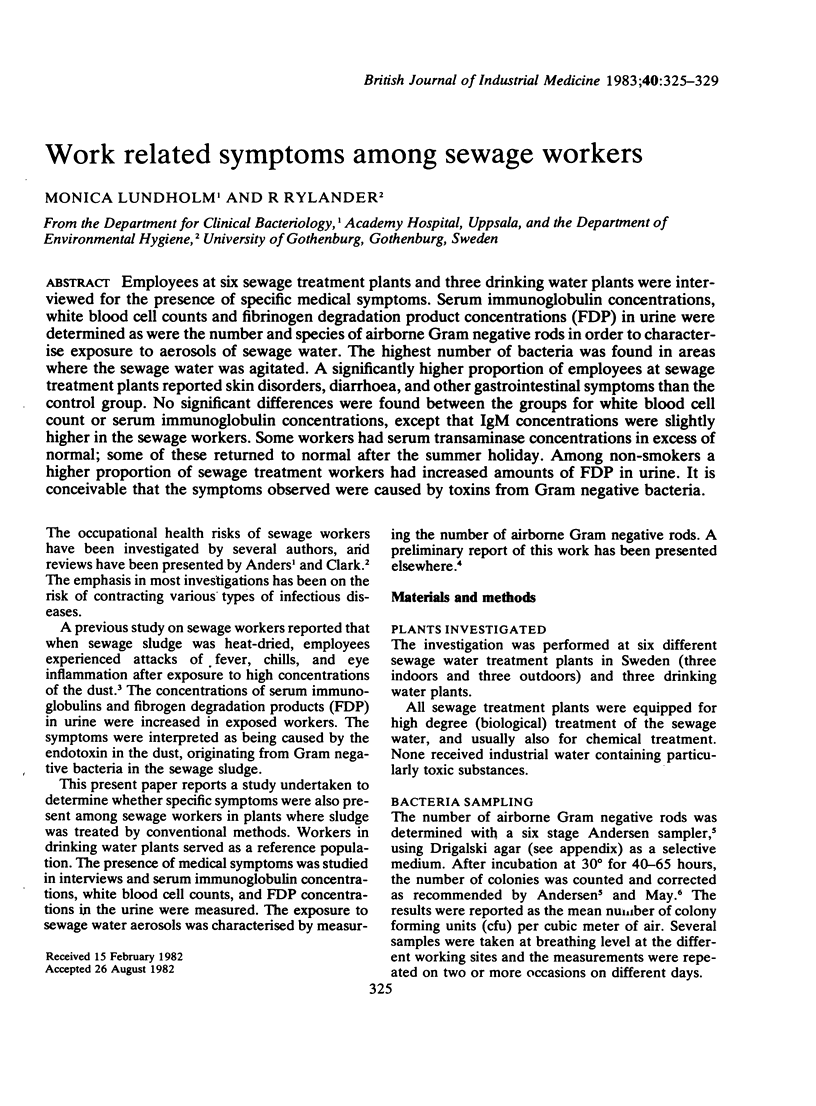
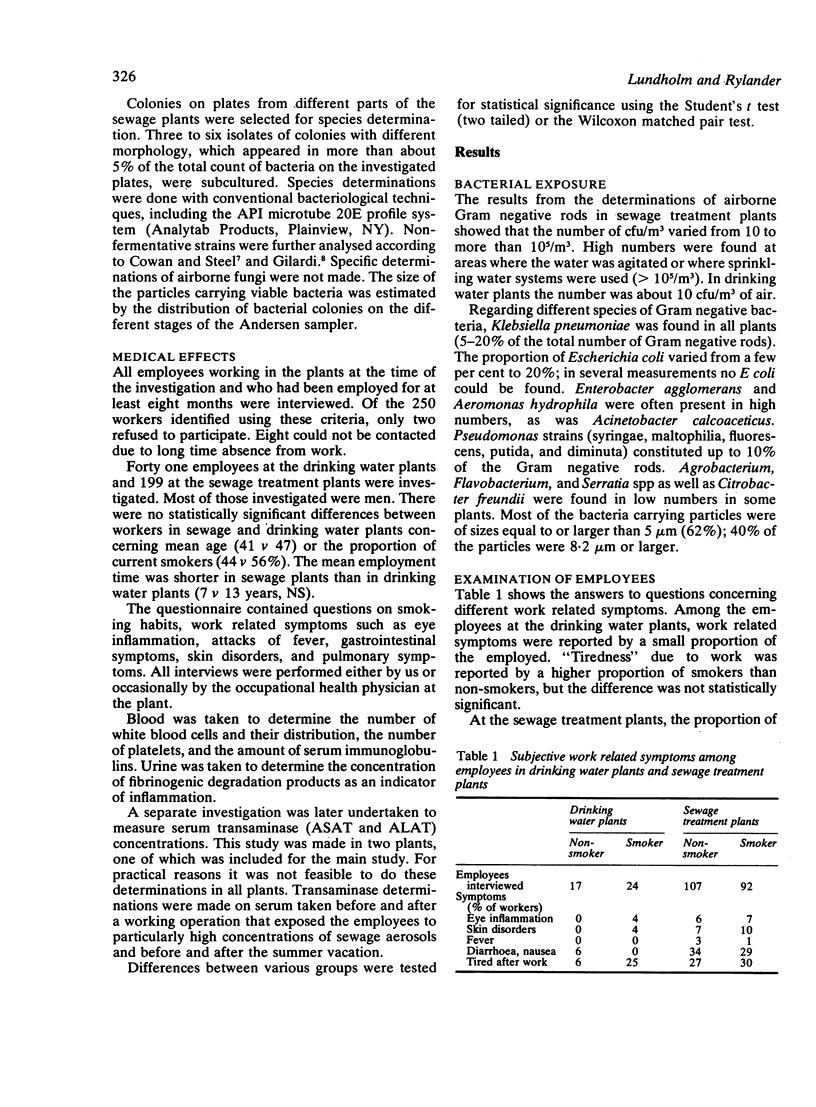
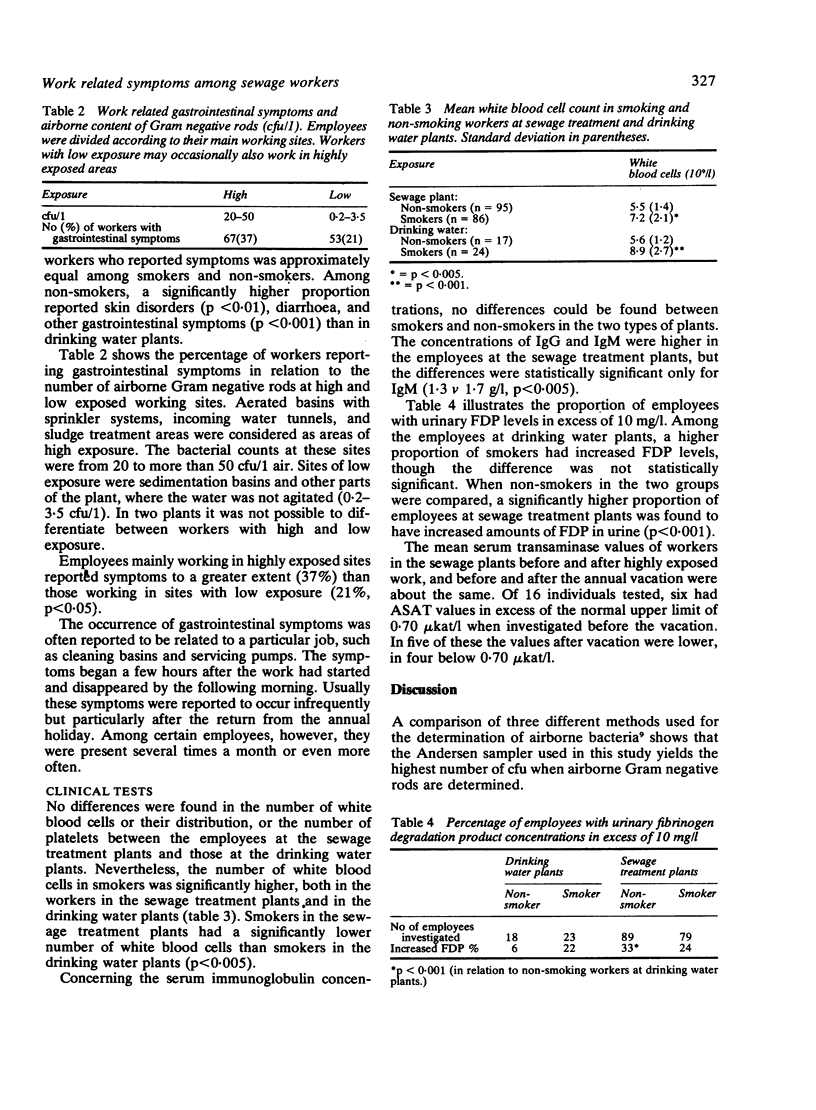
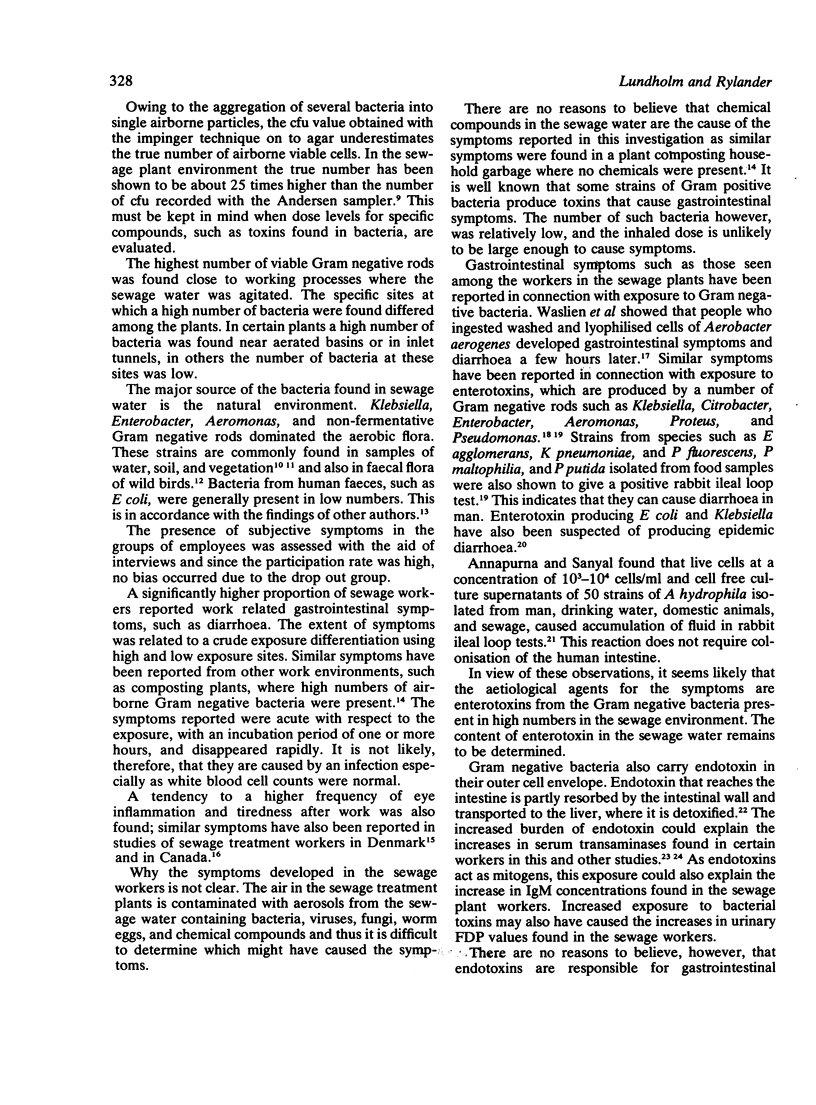
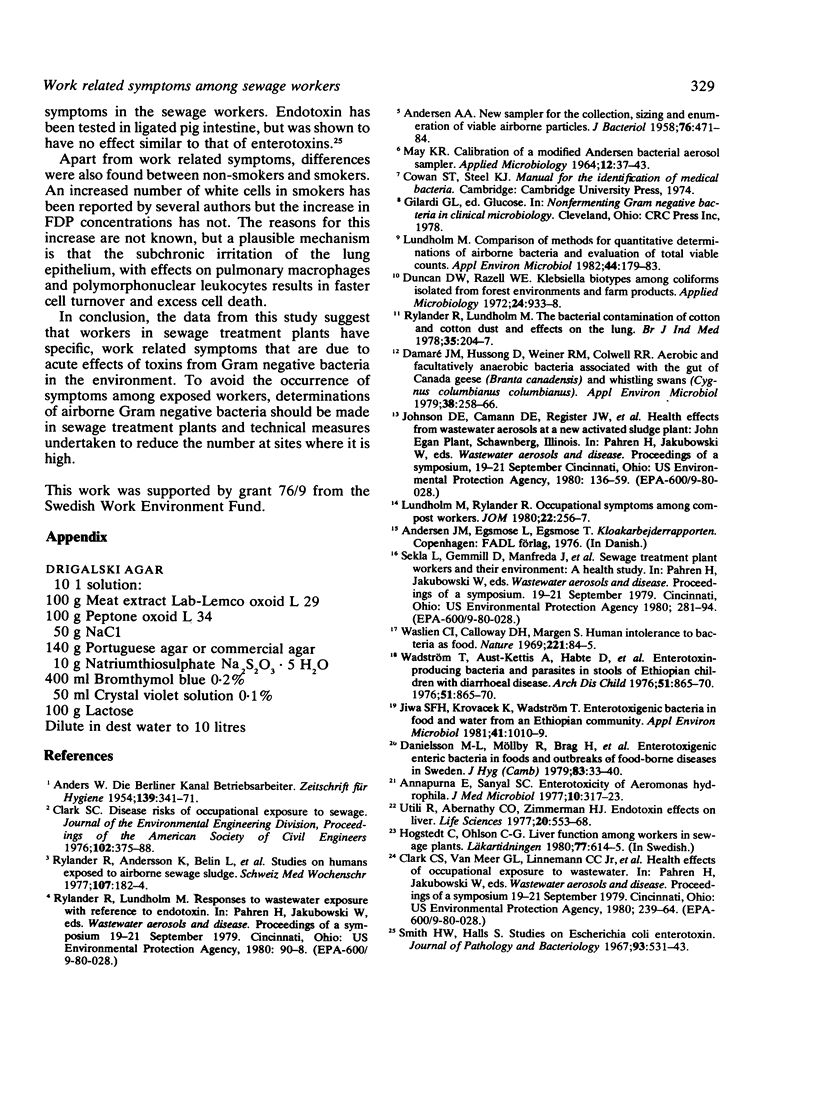
Selected References
These references are in PubMed. This may not be the complete list of references from this article.
- ANDERSEN A. A. New sampler for the collection, sizing, and enumeration of viable airborne particles. J Bacteriol. 1958 Nov;76(5):471–484. doi: 10.1128/jb.76.5.471-484.1958. [DOI] [PMC free article] [PubMed] [Google Scholar]
- Annapurna E., Sanyal S. C. Enterotoxicity of Aeromonas hydrophila. J Med Microbiol. 1977 Aug;10(3):317–323. doi: 10.1099/00222615-10-3-317. [DOI] [PubMed] [Google Scholar]
- Damaré J. M., Hussong D., Weiner R. M., Colwell R. R. Aerobic and facultatively anaerobic bacteria associated with the gut of Canada geese (Branta canadensis) and whistling swans (Cygnus columbianus columbianus). Appl Environ Microbiol. 1979 Aug;38(2):258–266. doi: 10.1128/aem.38.2.258-266.1979. [DOI] [PMC free article] [PubMed] [Google Scholar]
- Danielsson M. L., Möllby R., Brag H., Hansson N., Jonsson P., Olsson E., Wadström T. Enterotoxigenic enteric bacteria in foods and outbreaks of food-borne diseases in Sweden. J Hyg (Lond) 1979 Aug;83(1):33–40. doi: 10.1017/s0022172400025808. [DOI] [PMC free article] [PubMed] [Google Scholar]
- Duncan D. W., Razzell W. E. Klebsiella biotypes among coliforms isolated from forest environments and farm produce. Appl Microbiol. 1972 Dec;24(6):933–938. doi: 10.1128/am.24.6.933-938.1972. [DOI] [PMC free article] [PubMed] [Google Scholar]
- Jiwa S. F., Krovacek K., Wadström T. Enterotoxigenic bacteria in food and water from an Ethiopian community. Appl Environ Microbiol. 1981 Apr;41(4):1010–1019. doi: 10.1128/aem.41.4.1010-1019.1981. [DOI] [PMC free article] [PubMed] [Google Scholar]
- Lundholm I. M. Comparison of methods for quantitative determinations of airborne bacteria and evaluation of total viable counts. Appl Environ Microbiol. 1982 Jul;44(1):179–183. doi: 10.1128/aem.44.1.179-183.1982. [DOI] [PMC free article] [PubMed] [Google Scholar]
- Lundholm M., Rylander R. Occupational symptoms among compost workers. J Occup Med. 1980 Apr;22(4):256–257. [PubMed] [Google Scholar]
- MAY K. R. CALIBRATION OF A MODIFIED ANDERSEN BACTERIAL AEROSOL SAMPLER. Appl Microbiol. 1964 Jan;12:37–43. doi: 10.1128/am.12.1.37-43.1964. [DOI] [PMC free article] [PubMed] [Google Scholar]
- Rylander R., Andersson K., Belin L., Berglund G., Bergström R., Hanson L., Lundholm M., Mattsby I. Studies on humans exposed to airborne sewage sludge. Schweiz Med Wochenschr. 1977 Feb 12;107(6):182–184. [PubMed] [Google Scholar]
- Rylander R., Lundholm M. Bacterial contamination of cotton and cotton dust and effects on the lung. Br J Ind Med. 1978 Aug;35(3):204–207. doi: 10.1136/oem.35.3.204. [DOI] [PMC free article] [PubMed] [Google Scholar]
- Smith H. W., Halls S. Studies on Escherichia coli enterotoxin. J Pathol Bacteriol. 1967 Apr;93(2):531–543. doi: 10.1002/path.1700930212. [DOI] [PubMed] [Google Scholar]
- Utili R., Abernathy C. O., Zimmerman H. J. Endotoxin effects on the liver. Life Sci. 1977 Feb 15;20(4):553–568. doi: 10.1016/0024-3205(77)90458-1. [DOI] [PubMed] [Google Scholar]
- Wadström T., Aust-Kettis A., Habte D., Holmgren J., Meeuwisse G., Möllby R., Söderlind O. Enterotoxin-producing bacteria and parasites in stools of Ethiopian children with diarrhoeal disease. Arch Dis Child. 1976 Nov;51(11):865–870. doi: 10.1136/adc.51.11.865. [DOI] [PMC free article] [PubMed] [Google Scholar]
- Waslien C. I., Calloway D. H., Margen S. Human intolerance to bacteria as food. Nature. 1969 Jan 4;221(5175):84–85. doi: 10.1038/221084a0. [DOI] [PMC free article] [PubMed] [Google Scholar]


